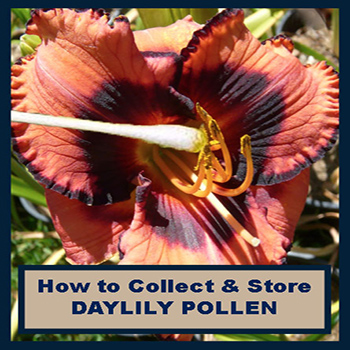Collecting and Storing Daylily Pollen, cross pollinating the daylily is very common all over the world including Australia and resulting cultivars are sometimes different in colour, texture and size from their parents. Breeding daylilies is although a time consuming and tough task at first, the results are usually very satisfying. One of the most important steps in breeding daylilies is collecting and storing pollen, since not all daylilies flowers are open at the same time, by doing this you are able to select the daylilies you wish to hand pollinate later on. Although there are several different ways of daylily pollen storage, we can go over a few ways that I know are most effective.
Collecting Daylily Pollen
One of the best ways to save pollen is to collect daylily pollen in a contact lens case. Cut the lens case into two and make a numbered list of your pollen parents to correspond with the numbers on the cases. The best time to collect the pollen is towards midday when daylilies are fully open so that the pollen is true to type cover the flower with fine netted fabric to keep the bees or other insects off early in the morning. The pollen should be ready to harvest when the pollen is only dry and fluffy. Pollen can be collected directly from the anthers and in various stages of dehydration. This technique should be followed in controlled conditions which helps pollen to swell naturally. However, the easiest and probably most used method to collect pollens is to take the stem part of plant and the pollen. Put it in an envelope, mark it for identification purposes and put all envelops in a bag or container, or either you can also scrape the pollen into a small air tight container with a tooth pick or something that is sterilised. Another way is to use a cotton bud tap the pollen, gently touching the anthers by taking a swab with the cotton bud adding the lot into a sealed air tight container. The information on the sealed container should contain the date, daylily variety and ploidy. Why ploidy because there are two different pollens diploid and tetraploid and this will save looking up which daylily is tetraploid and which daylily is a diploid when it comes time to pollinate the daylily.
How to Store Daylily Pollen
It’s hard to distinguish dead pollen from alive, therefore, it’s very important to store pollen properly to prevent it from dying. Pollen usually stays fresh for a week at room temperature, while it last longer in the fridge.
Freezing Daylily Pollen
For long term storage, a very cheap method is to put pollen in the freezer in zip lock bags. Another preferred method is to use glass or plastic tubes or jars. It’s important to make sure containers are air tight as air can cause fungi to form and pollen becomes less viable. Additional dried pollen can be added to the same container on subsequent days, but don’t let the frozen pollen thaw out and return it immediately to the freezer. To reduce the water content in the pollen, use a desiccant. It’s recommended to use an indicating desiccant which can be used over & over again.
Cross Pollination of Daylilies
One of the main reasons why daylilies are popular and in demand. It is that they lend themselves very easily for cross-pollination. Anyone can try this at their home even someone who is new to gardening. The first thing to determine is which day lily is good, for cross pollination as choosing good parents will result in the best quality result. Then, decide on which qualities of those plants you want to cross pollinate like colour, good bud count etc. Once you’ve decided that, acquire pollen by using one of the methods above. Keep in mind that sometimes cross-pollination does not work as intended, especially if you’re someone new to this. Results are not always positive due to different blossom times, incompatibility between two daylilies and unconditional weather.
Give It a Try
Daylilies are very easy to pollinate, all the parts that must be manipulated to pollinate are fairly large and can be easily handled. Because of this, getting started in hybridising your own daylilies is doable, just make sure to use care during collecting and storing of pollen, and you’ll be on your way to have a beautiful garden.

